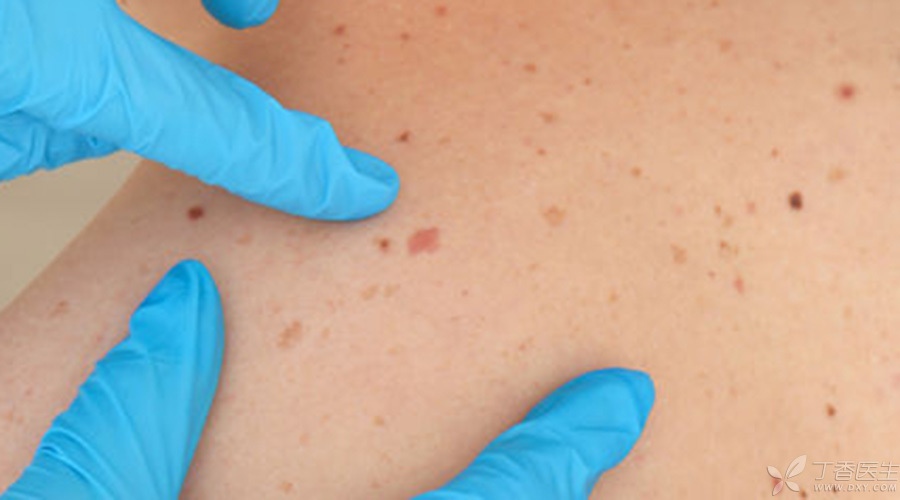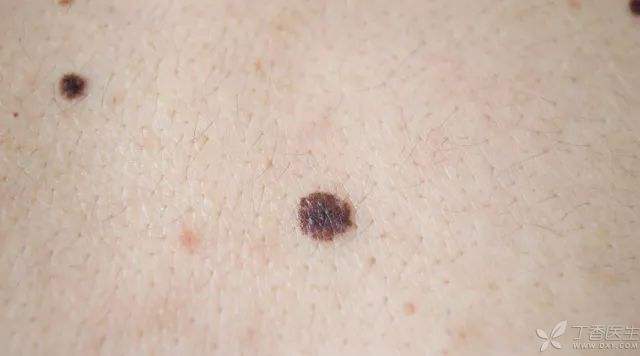
I cut off a 20-to 30-year-old pigmented mole on my back today.
As a dermatologist, I am often asked various questions about moles:
[Doctor, my mole seems to be getting bigger. Will it become cancerous? ]
[I heard that laser mole removal is effective, isn’t it? ]
[Does it hurt to cut moles in the hospital? Will there be scars? ]
Today, let’s talk about some common problems of moles.
Where does the mole come from?
We often refer to nevus, usually refers to pigmented nevus, from melanocytes in the skin.
Perhaps you have heard from movies and TV works that pigmented nevus can deteriorate, although the probability is very low among yellow people, about two or three out of 100,000 people.
Why is this happening? We will understand from the perspective of pathology.

Under normal circumstances, melanocytes are evenly distributed in the skin.
The pigmented nevus, on the other hand, is formed by increasing the number of melanocytes and forming a mass (nevus cell mass). Simply put, the essence of pigmented nevus is a benign tumor.
However, if one day the pigmented nevus is stimulated by what and cannot think of it, the nucleus starts to show abnormalities, and proliferates crazily, even stirring to spread to the whole body through lymphatic vessels and blood vessels, it becomes a malignant melanoma.
Remove nevus to cut off, do not use laser cauterization
Some characteristics can help us preliminarily judge whether a mole will become cancerous, such as:
- Most of the children are benign, and those who grow up after the age of 30 should be on guard. It is safer to be located in the parts that are not subject to friction, and the parts that are often rubbed, such as palms and soles, should be on guard. If you have recurred many times after laser nevus removal, you should be on guard. Boundary irregular, uneven color, or blue-black mole, to be on guard; Nevus that rapidly increases and breaks in a short period of time should be on high alert.
Of course, there are also some pigmented nevus that we think are actually an early melanoma, just because it is shallow and has not spread to the distance.
At this time, if it is not moved, it may not progress, or it may be cut off at an early stage, and the probability of complete eradication is also very high. The most afraid is to be mistaken for pigmented nevus and used laser to spot it.
I have seen a person who found a recurrence of a [mole] on his ear after laser burning, and the range of pigment staining was much larger than before. Only then did I realize that it was a melanoma and finally had to cut off the whole ear. However, if it is not enlarged and removed quickly, once it metastasizes or even enters the brain, it will be a narrow escape.

Therefore, for nevus, either do not move it or cut it off surgically, do not use laser or corrosive liquid medicine, because these may increase the risk of canceration.
The mole I cut off this time grows on the upper left of the lower back and can be felt as long as I can remember. As I grow older, it also slowly thickens. In fact, my mole is probably benign and can be cut without cutting.
However, because I often can’t help touching it, in theory, moles that are often stimulated by friction have a slightly higher probability of canceration.
After thinking for a long time, I decided: Since I can’t chop my hands, I’d better cut the mole sometime.
Removing nevus is a minor operation, don’t worry
Scientific mole removal is to go to a regular hospital to cut it off.
This is a very small operation, which can be completed in 20 minutes by local anesthesia in dermatological clinic.
Many people are afraid that cutting will leave scars and not look good. In fact, there is no need to worry. As long as it is not scar constitution, leaving a thin white line is better than a lump of black pimples.
Besides, the surgical incision is an inverted pyramid. After the skin on both sides is drawn and sutured, the incision is actually smaller than that of laser cauterization.

As for myself, the reason why I hesitated for a long time and did not cut it was because it was not urgent and because I was waiting for a suitable person: to be quick and gentle.
I mean it, don’t laugh.
Many doctors are very refreshing when cutting others. When they are cut, they are eager for humanistic care. They wish to send me a plush bear after cutting, praising me for being so brave.
Even if not, it is OK to talk to me and comfort me while cutting. But all my colleagues can only say: [what cut? Come on, come on, I’m just practicing my hands.]
… …
So I waited until I went out to study. I observed several teachers in other hospitals and found that they moved gently and smoothly. I also talked with patients about trivial matters of life to relieve the tension.
That’s wonderful! That’s who I’m looking for! So I quickly went to make a bill to pay and lay prone on the operating table.
The teacher entered the outpatient operating room and gave me a look: [Is that you? ]
[Well, yes. Please be quiet, teacher! ]
[Ouch, just cut a mole and what’s light ones… do you think you are melodramatic… do you still cut less others’ ones? What feels that you don’t have any points in your heart, ah, count…]
What about the agreed humanistic care? Before I could react, I heard the teacher say:
[Finished.]
? ? ?
With a bitterly [oh] cry, I put down my coat and climbed down. The back was only stretched with adhesive tape. I looked at the lone mole on the gauze in the tray. It was so small.
It seems that it is really a very small thing.
As a dermatologist who has undergone mole cutting and has also undergone mole cutting, I would like to share my knowledge and experience to tell you:
If you want to remove moles, you’d better go to the hospital to cut them off. This is a minor operation. Don’t be afraid.
But don’t go to the beauty salon and light it with a laser.
